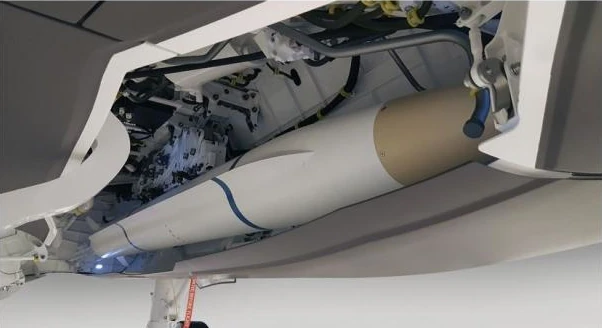The United States is anticipated to supply Poland with up to 360 Advanced Anti-Radiation Guided Missiles-Extended Range (AARGM-ER). Implementing AARGM-ER will substantially bolster the Polish Air Force’s capacity to counter Russian ground-based air defense systems. The Suppression of Enemy Air Defences (SEAD) or Destruction of Enemy Air Defences (DEAD) against hostile air defense depends critically on the AARGM family of missiles.
In the context of SEAD/DEAD, AARGM, specifically the most recent iteration AARGM-ER, ensures the destruction of hostile radars, including those installed on mobile military air defense systems (Pantsir, OSA, Buk), territorial air defense systems (S-300 and S-400), and a variety of standalone surveillance and tracking radars. Additionally, naval radars and all radio wave sources, including electronic warfare assets, are susceptible to the missile’s impact.
The AARGM-ER is a multipurpose weapon because of its onboard millimeter-wave radar and inertial/satellite navigation. It may target other important targets, such as enemy ballistic missile locations, and zero in on hostile radars that have been turned off for defensive reasons.
Polish F-35A Lightning II aircraft will be used as carriers for the AARGM-ER. The Americans could also integrate it into Polish F-16C/D Fighting Falcons.
However, AARGM-ER is currently limited to use by electronic warfare aircraft EA-18G Growlers and multirole naval F/A-18E/F Super Hornets. The F-35A and AARGM-ER form a potent weapon system that can destroy opponent air defense systems with almost total impunity. But, AARGM-ER has not yet been fully incorporated into the F-35. The roughly $100 million integration project, which includes numerous live firings and extremely difficult testing, won’t be finished until 2026.
By way of the Defense Security Cooperation Agency (DSCA), the United States Department of State has authorized a potential sale to Poland of 360 AARGM-ER missiles for a maximum of $1.275 billion. Equally as many spare guidance units and eight missile control sections are included in the offer. In addition, DSCA has provided Poland with “other related logistics and program support elements,” including training rounds, missile containers, software, training, support equipment, spare and repair parts, satellite navigation with jam-resistant M-Code, transportation from the United States to Poland, and support services.
The Polish sale of AARGM-ER, according to DSCA, will bolster the security of the NATO ally, which is a catalyst for economic development and political stability in Europe. The same day, DSCA authorized a prospective $700 million sale of up to 265 AARGM-ER missiles to the Netherlands. The breakdown of additional equipment/services and the volumes of spare parts are identical to those detailed in the Polish offer document.
Nevertheless, the Polish AARGM-ER commands a unit price of one million dollars more expensive than the Dutch missile. However, there is no reason to suspect foul play regarding DSCA, as the US government purchases military equipment directly from the manufacturer and sells it to allies via Foreign Military Sale (FMS) mechanisms. All allies are charged the same price for the specified period and location. Nevertheless, the DSCA list is all-encompassing, and the phrase “other related logistics and program support elements” may encompass many items.

The most recent iteration, known as the AARGM-ER, constitutes a noteworthy addition to the AGM-88 HARM (High-speed Anti-Radiation Missile) lineage, which also includes subsequent iterations such as the AGM-88E AARGM (Advanced Anti-radiation Guided Missile). While bearing the seeker head and certain electronic components from preceding iterations, the AARGM-ER is distinguished by its new warhead, rocket motor, and an entirely redesigned body that omits substantial control surfaces while improving aerodynamic performance. As a result, AARGM-ER can fit within the internal compartments of F-35A/B/C aircraft.
The AARGM-ER exhibits enhanced capabilities compared to its predecessor, the AGM-88E AARGM. The substantial increase in maximal velocity to Mach 2 will expedite the breach of adversary air defenses. The range is estimated to be 250 kilometers.
Based on the AARGM-ER, the Stand-in Attack Weapon (SiAW), a versatile missile, is developed. Its mission will be to eliminate “rapidly relocatable targets” that are highly valuable and are integral to the enemy’s air defense. Other valuable targets include anti-satellite systems, command and control centers, missile systems, and electronic warfare assets.
Combatting enemy air defense is a complex task. Given the high cost of AARGM-ER and the risk of its destruction, it is more than desirable to deploy deceptive and jamming targets like ADM-160 MALD (Miniature Air-Launched Decoy). The advantage is their cost, which is only in the “mere” hundreds of thousands of dollars—several MALD decoys can be purchased for the price of a single AARGM-ER. Additionally, MALD can “provoke” the activation of enemy air defense radars, which AARGM-ER can then target.
